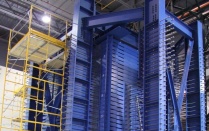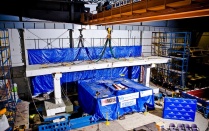
Andrew S. Whittaker
PhD, PE, SE
SUNY Distinguished Professor
Director
Interim Director
Registered Civil and Structural Engineer
State of California
Research Topics
Structural and earthquake engineering; Bridge engineering; Blast and impact engineering; Performance-based engineering, nuclear structures
- Lal, K. M., S. S. Parsi, B. D. Kosbab, E. Ingersoll, H. Charkas, and A. S. Whittaker, “Towards standardized advanced nuclear reactors: seismic isolation and the impact of the earthquake load case,” Nuclear Engineering and Design, Vol. 386, January 2022, DOI: 10.1016/j.nucengdes.2021.111487.
- Parsi, S.S., G. Mertz, and A. S. Whittaker, “Evaluation of design equations for out-of-plane shear strength of deep concrete sections in nuclear power plant buildings,” Nuclear Engineering and Design, Vol. 386, January 2022, DOI: 10.1016/j.nucengdes.2021.111545.
- Yu, C.-C, and A. S. Whittaker, “A process to verify numerical models for seismic fluid-structure interaction in advanced reactor vessels,” Nuclear Engineering and Design, Vol. 387, February 2022, DOI: 10.1016/j.nucengdes.2021.111580.
- Parsi, S. S., K. M. Lal, B. D. Kosbab, E. Ingersoll, K. Shirvan, and A. S. Whittaker, “Seismic isolation: a pathway to standardized advanced nuclear reactors,” Nuclear Engineering and Design, Vol. 387, February 2022, DOI: 10.1016/j.nucengdes.2021.111445.
- Terranova, B. R., L. Schwer, and A. S. Whittaker, “Simulation of projectile impact on steel plate-lined, reinforced concrete panels using the smooth particle hydrodynamics formulation,” International Journal of Protective Structures, Vol. 13, No. 1, pp. 65-79, March 2022, DOI: 10.1177/20414196211042036.
- Mir, F. U. H., K. M. Lal, M. C. Constantinou, and A. S. Whittaker, “Validation of a numerical model of a fluid-filled, seismically isolated cylindrical vessel,” Earthquake Engineering and Structural Dynamics, Vol. 51, No. 8, pp. 1857-1873, July 2022, DOI: 10.1002/eqe.3642.
- Dhulipala, S. L. N, C. Bolisetti, L. B. Munday, W. H. Hoffman, C.-C. Yu, F. U. H. Mir, F. Kong, A. D. Lindsay, and A. S. Whittaker, “Development, verification, and validation of comprehensive acoustic fluid-structure interaction capabilities in an open-source computational platform,” Earthquake Engineering and Structural Dynamics, Vol. 51, No. 10, pp. 2188-2219, August 2022, DOI: 10.1002/eqe.3659.
- Mir, F. U. H., and A. S. Whittaker, “Dynamic responses of submerged components in advanced reactors: experimental and numerical studies” Earthquake Spectra, Vol. 38, No. 4, pp. 3063-3088, November 2022, DOI: 10.1177/87552930221112689.
- Mir, F. U. H., N. Nguyen, B. Song, B. D. Kosbab, and A. S. Whittaker, “Sloshing loads on the head of an annular, cylindrical reactor vessel,” Nuclear Technology, Vol. 209, No. 2, pp. 244-253, January 2023, DOI: 10.1080/00295450.2022.2118484.
- Lal, K. M., A. S. Whittaker, and M. C. Constantinou, “Mid-height seismic isolation of equipment in nuclear power plants,” Earthquake Engineering & Structural Dynamics, Vol. 52, No. 4, April 2023, pp. 998-1015, DOI: 10.1002/eqe.3798.
- Parsi, S. S., M. V. Sivaselvan, and A. S. Whittaker, “Nuances in modeling and impedance-inspired control of shake tables for tracking ground-motion trajectories,” Earthquake Engineering & Structural Dynamics, Vol. 52, No. 5, April 2023, pp. 1403-1422, DOI: 10.1002/eqe.3822.
- Yu, C.-C., A. S. Whittaker, B. D. Kosbab, and P. K. Tehrani, “Earthquake-induced impact of base-isolated buildings: theory, numerical modeling, and design solutions,” Earthquake Engineering & Structural Dynamics, Vol. 52, No. 5, April 2023, pp. 1445-1462, DOI: 10.1002/eqe.3824.
- Mir, F. U. H., A. S. Whittaker, B. D. Kosbab, and N. Nguyen, “Characterizing the seismic response of a molten salt nuclear reactor,” Earthquake Engineering & Structural Dynamics, Vol. 52, No. 7, pp. 2025-2046, June 2023, DOI: 10.1002/eqe.3866.
- Parsi, S. S., M. V. Sivaselvan, and A. S. Whittaker, “Impedance-matching model-in-the-loop simulation,” Earthquake Engineering & Structural Dynamics, June 2023, DOI: 10.1002/eqe.3922.
- Lal, K. M., A. S. Whittaker, and M. V. Sivaselvan, “Mid-height seismic isolation of safety-class equipment in nuclear power plants: numerical simulations and design recommendations,” Nuclear Engineering and Design, Vol. 408, July 2023, DOI: 10.1016/j.nucengdes.2023.112286.









